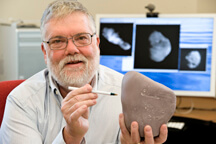Purdue scientists part of NASA return mission to comet

Jay Melosh, a distinguished professor of earth and atmospheric sciences and physics at Purdue, holds a model of the comet Tempel 1. Melosh is part of the science team for NASA's Stardust-NExT mission. (Purdue University file photo/Andrew Hancock)
WEST LAFAYETTE, Ind. - Two Purdue University professors and a student are part of the NASA science team returning to the comet Tempel 1 to study changes that occur as a comet approaches the sun and to potentially examine an impact crater created during an earlier mission.
Purdue professors Jay Melosh and Jim Richardson and graduate student Tim Bowling are part of the science team for NASA's Stardust New Exploration of Tempel 1, or Stardust-NExT, mission that flew within about 112 miles of the comet at 11:39 p.m. on Monday (Feb. 14). Images captured by the spacecraft will be downloaded over the next few days.
This is the second look at Tempel 1 for Melosh and Richardson, both of whom were part of the 2005 Deep Impact mission that launched a probe into the comet, creating an impact crater on its surface.
Melosh, a distinguished professor of earth and atmospheric sciences and physics and an expert in impact cratering, said this would be the scientists' first look at the crater. Dust resulting from the impact in 2005 had blocked the view of the newly formed crater.
"We hope that the crater will reveal something about the interiors of comets," Melosh said. "The size and shape of the crater can tell us about strength and structure of the material. For instance, if the crater is much deeper than fresh craters on the moon, then it tells us that the comet has a porous interior. If the crater is flat, it tells us that the cometary interior flowed like a fluid just after the impact; and if the crater has a small cliff around its rim, then it means there is a hard surface layer on the comet. Until we get a look at it, we will not know if our prediction and, thus, our theories of how craters form on comets is correct."
Melosh and Bowling have been working on simulations of the collision between the Deep Impact probe and Tempel 1 and the resulting impact crater. The team predicts that the crater will be about 100 meters in diameter, which would be expected for a porous and weak material.
This mission also is the first to revisit a comet and compare observations before and after a single orbit around the sun, Melosh said.
"We hope to see part of the comet that we were unable to image in 2005 because it was in darkness," he said. "By comparing the terrain we saw in 2005 to what we will observe on this encounter, we will better understand how a comet's surface changes during its excursions into the inner solar system."
Richardson, an assistant research professor of earth and atmospheric sciences, said the extent and visibility of the debris produced when the crater was formed - called the ejecta blanket - will give important clues as to the nature of the comet and its environment.
The debris ejected from the Deep Impact collision was composed of extremely tiny particles consisting of a combination of water ice and silicate dust, he said. Some of these particles were ejected at speeds high enough to cause them to escape the comet forever, forming the plume that was visible from Earth-based telescopes. However some were ejected at slower speeds and landed back on the comet's surface. While the ice component of these particles has long since been lost due to heating and vaporization as the comet orbited the sun, their silicate dust component should have left behind a blanket of material on the surface that is thickest closest to the impact crater and becoming thinner with distance from the impact site.
Richardson has been working on simulations of the ejecta plume and blanket from the Deep Impact mission.
"It was thrilling to have performed an impact experiment of this magnitude in the first place, but to be able to go back and re-examine the results of that experiment after the 'dust has cleared' is wonderful," Richardson said. "Through the crater, ejecta blanket and other changes in the comet's surface, we will be able to glean further information about the comet's structure and composition and the near-surface environment, which are very different from what we are familiar with here on Earth."
Melosh, Richardson and Bowling are at mission control at NASA's Jet Propulsion Laboratory in Pasadena, Calif.
NASA's Jet Propulsion Laboratory manages the Stardust-NExT mission for NASA's Science Mission Directorate. Joe Veverka of Cornell University is the mission's principal investigator.
A press conference will be held at 1 p.m. Eastern time Tuesday (Feb. 15) at mission control and will be available via NASA TV and webcast and a Jet Propulsion Laboratory Ustream channel. During events, viewers can take part in a real-time chat and submit questions to the Stardust-NExT team at https://www.ustream.tv/user/NASAJPL2
More information is available at https://stardustnext.jpl.nasa.gov/index.html
Writer: Elizabeth K. Gardner, 765-494-2081, ekgardner@purdue.edu
Sources: Jay Melosh, jmelosh@purdue.edu
Jim Richardson, Richardson@purdue.edu
Tim Bowling, tbowling@purdue.edu
Related news releases:
